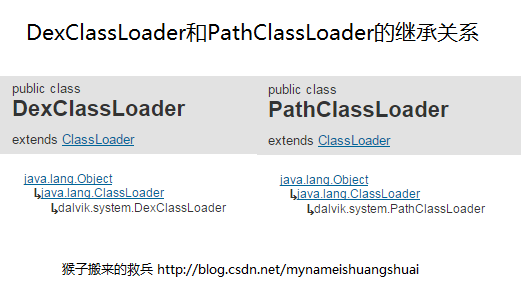DexClassLoader和PathClassLoader的区别
2016-10-05 10:53
183 查看
在使用Java虚拟机时,我们经常自定义继承自ClassLoader的类加载器。然后通过defineClass方法来从一个二进制流中加载Class。而在Android中我们无法这么使用,Android中ClassLoader的defineClass方法具体是调用VMClassLoader的defineClass本地静态方法。而这个本地方法什么都没做,只是抛出了一个“UnsupportedOperationException”异常。
既然在Dalvik虚拟机里,ClassLoader不好用,那么Android官方为了解决这个问题,帮我们从ClassLoader中派生出了两个类:DexClassLoader和PathClassLoader。咋一看两者很像,那么究竟二者在使用上面有何不同,这里我和大家一起探讨一下。
首先来看一下二者的构造方法
参数详解:
dexPath:dex文件路径列表,多个路径使用”:”分隔
dexOutputDir:经过优化的dex文件(odex)文件输出目录
libPath:动态库路径(将被添加到app动态库搜索路径列表中)
parent:这是一个ClassLoader,这个参数的主要作用是保留java中ClassLoader的委托机制(优先父类加载器加载classes,由上而下的加载机制,防止重复加载类字节码)
DexClassLoader是一个可以从包含classes.dex实体的.jar或.apk文件中加载classes的类加载器。可以用于实现dex的动态加载、代码热更新等等。这个类加载器必须要一个app的私有、可写目录来缓存经过优化的classes(odex文件),使用Context.getDir(String, int)方法可以创建一个这样的目录,例如:
参数详解:
path:文件或者目录的列表
libPath:包含lib库的目录列表
parent:父类加载器
PathClassLoader提供一个简单的ClassLoader实现,可以操作在本地文件系统的文件列表或目录中的classes,但不可以从网络中加载classes。
为了便于理解,我们查看一下二者的源码:

很明显两者都继承于BaseDexClassLoader类,并做了一下封装,具体的实现还是在父类里。不难看出,主要的区别在于PathClassLoader的optimizedDirectory参数只能是null,那么optimizedDirectory是做什么用的呢?我们进BaseDexClassLoader去看看这个参数。
代码中与optimizedDirectory有关的地方是new 一个DexPathList实例。
optimizedDirectory是用来缓存我们需要加载的dex文件的,并创建一个DexFile对象,如果它为null,那么会直接使用dex文件原有的路径来创建DexFile
对象。
optimizedDirectory必须是一个内部存储路径,无论哪种动态加载,加载的可执行文件一定要存放在内部存储。DexClassLoader可以指定自己的optimizedDirectory,所以它可以加载外部的dex,因为这个dex会被复制到内部路径的optimizedDirectory;而PathClassLoader没有optimizedDirectory,所以它只能加载内部的dex,这些大都是存在系统中已经安装过的apk里面的。
PathClassLoader:只能加载系统中已经安装过的apk
参考链接:
http://www.jianshu.com/p/669fc4858194
既然在Dalvik虚拟机里,ClassLoader不好用,那么Android官方为了解决这个问题,帮我们从ClassLoader中派生出了两个类:DexClassLoader和PathClassLoader。咋一看两者很像,那么究竟二者在使用上面有何不同,这里我和大家一起探讨一下。
首先来看一下二者的构造方法
DexClassLoader
public DexClassLoader (String dexPath, String dexOutputDir, String libPath, ClassLoader parent)
参数详解:
dexPath:dex文件路径列表,多个路径使用”:”分隔
dexOutputDir:经过优化的dex文件(odex)文件输出目录
libPath:动态库路径(将被添加到app动态库搜索路径列表中)
parent:这是一个ClassLoader,这个参数的主要作用是保留java中ClassLoader的委托机制(优先父类加载器加载classes,由上而下的加载机制,防止重复加载类字节码)
DexClassLoader是一个可以从包含classes.dex实体的.jar或.apk文件中加载classes的类加载器。可以用于实现dex的动态加载、代码热更新等等。这个类加载器必须要一个app的私有、可写目录来缓存经过优化的classes(odex文件),使用Context.getDir(String, int)方法可以创建一个这样的目录,例如:
File dexOutputDir = context.getDir(“dex”, 0);
PathClassLoader
PathClassLoader提供两个常用构造方法public PathClassLoader (String path, ClassLoader parent)
public PathClassLoader (String path, String libPath, ClassLoader parent)
参数详解:
path:文件或者目录的列表
libPath:包含lib库的目录列表
parent:父类加载器
PathClassLoader提供一个简单的ClassLoader实现,可以操作在本地文件系统的文件列表或目录中的classes,但不可以从网络中加载classes。
为了便于理解,我们查看一下二者的源码:

// DexClassLoader.java
public class DexClassLoader extends BaseDexClassLoader {
public DexClassLoader(String dexPath, String optimizedDirectory,
String libraryPath, ClassLoader parent) {
super(dexPath, new File(optimizedDirectory), libraryPath, parent);
}
}
// 版权所有,猴子搬来的救兵http://blog.csdn.net/mynameishuangshuai
// PathClassLoader.java
public class PathClassLoader extends BaseDexClassLoader {
public PathClassLoader(String dexPath, ClassLoader parent) {
super(dexPath, null, null, parent);
}
public PathClassLoader(String dexPath, String libraryPath,
ClassLoader parent) {
super(dexPath, null, libraryPath, parent);
}
}很明显两者都继承于BaseDexClassLoader类,并做了一下封装,具体的实现还是在父类里。不难看出,主要的区别在于PathClassLoader的optimizedDirectory参数只能是null,那么optimizedDirectory是做什么用的呢?我们进BaseDexClassLoader去看看这个参数。
public BaseDexClassLoader(String dexPath, File optimizedDirectory,
String libraryPath, ClassLoader parent) {
super(parent);
this.originalPath = dexPath;
this.pathList = new DexPathList(this, dexPath, libraryPath, optimizedDirectory);
}代码中与optimizedDirectory有关的地方是new 一个DexPathList实例。
public DexPathList(ClassLoader definingContext, String dexPath,
String libraryPath, File optimizedDirectory) {
……
this.dexElements = makeDexElements(splitDexPath(dexPath), optimizedDirectory);
}
private static Element[] makeDexElements(ArrayList<File> files,
File optimizedDirectory) {
ArrayList<Element> elements = new ArrayList<Element>();
for (File file : files) {
ZipFile zip = null;
DexFile dex = null;
String name = file.getName();
if (name.endsWith(DEX_SUFFIX)) {
dex = loadDexFile(file, optimizedDirectory);
} else if (name.endsWith(APK_SUFFIX) || name.endsWith(JAR_SUFFIX)
|| name.endsWith(ZIP_SUFFIX)) {
zip = new ZipFile(file);
}
……
if ((zip != null) || (dex != null)) {
elements.add(new Element(file, zip, dex));
}
}
return elements.toArray(new Element[elements.size()]);
}
private static DexFile loadDexFile(File file, File optimizedDirectory)
throws IOException {
if (optimizedDirectory == null) {
return new DexFile(file);
} else {
String optimizedPath = optimizedPathFor(file, optimizedDirectory);
return DexFile.loadDex(file.getPath(), optimizedPath, 0);
}
}
/**
* Converts a dex/jar file path and an output directory to an
* output file path for an associated optimized dex file.
*/
private static String optimizedPathFor(File path,
File optimizedDirectory) {
String fileName = path.getName();
if (!fileName.endsWith(DEX_SUFFIX)) {
int lastDot = fileName.lastIndexOf(".");
if (lastDot < 0) {
fileName += DEX_SUFFIX;
} else {
StringBuilder sb = new StringBuilder(lastDot + 4);
sb.append(fileName, 0, lastDot);
sb.append(DEX_SUFFIX);
fileName = sb.toString();
}
}
File result = new File(optimizedDirectory, fileName);
return result.getPath();
}optimizedDirectory是用来缓存我们需要加载的dex文件的,并创建一个DexFile对象,如果它为null,那么会直接使用dex文件原有的路径来创建DexFile
对象。
optimizedDirectory必须是一个内部存储路径,无论哪种动态加载,加载的可执行文件一定要存放在内部存储。DexClassLoader可以指定自己的optimizedDirectory,所以它可以加载外部的dex,因为这个dex会被复制到内部路径的optimizedDirectory;而PathClassLoader没有optimizedDirectory,所以它只能加载内部的dex,这些大都是存在系统中已经安装过的apk里面的。
通过以上的分析,我们可以得出二者功能上的区别
DexClassLoader:能够加载未安装的jar/apk/dexPathClassLoader:只能加载系统中已经安装过的apk
参考链接:
http://www.jianshu.com/p/669fc4858194
相关文章推荐
- dexclassloader与pathclassloader的区别
- DexClassLoader和PathClassLoader的区别
- PathDexClassLoader 和 DexClassLoader 区别
- DexClassLoader和PathClassLoader加载Dex流程
- [置顶] Android类加载之PathClassLoader和DexClassLoader
- JAVA classpath路径问题以及Class.getResource()和ClassLoader.getResource()的区别
- DexClassLoader和PathClassLoader的区别
- 异常解决方案:java.lang.ClassNotFoundException:XXX.XXX.XXXX in loader dalvik.system.PathClassLoader
- ClassPathXmlApplicationContext 和FileSystemXmlApplicationContext的区别
- ClassLoader.loadClass()与Class.forName()的区别
- Spring加载resource时classpath*:与classpath:的区别
- Spring加载resource时classpath*:与classpath:的区别
- Android中java.lang.ClassNotFoundException: ***.**** in loader dalvik.system.PathClassLoader[/data/app
- ClassPathXmlApplicationContext 和FileSystemXmlApplicationContext的区别
- 区别:Thread.currentThread().getContextClassLoader() and Class.getClassLoader()
- JAVA 笔记 ClassLoader.getResourceAsStream() 与 Class.getResourceAsStream()的区别
- Class.forName()与ClassLoader.loadClass()的区别
- ClassPathXmlApplicationContext()与FileSystemXmlApplicationContext() 区别
- 区别:Thread.currentThread().getContextClassLoader() and Class.getClassLoader()
- 转:Class.forName和ClassLoader.loadClass的区别
